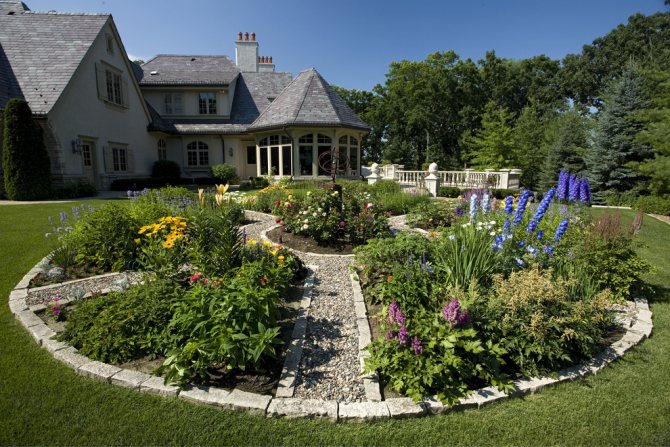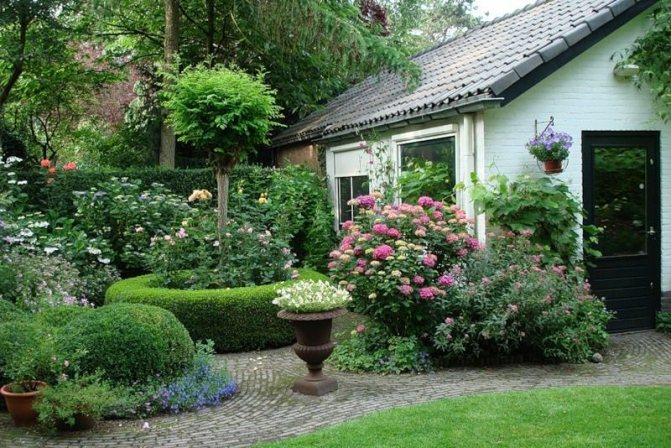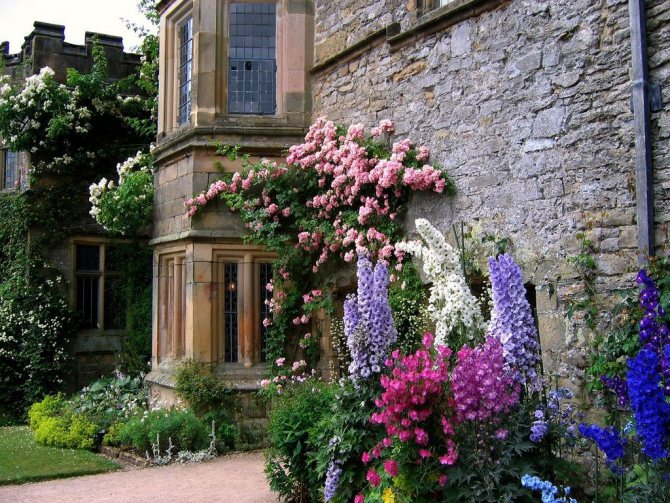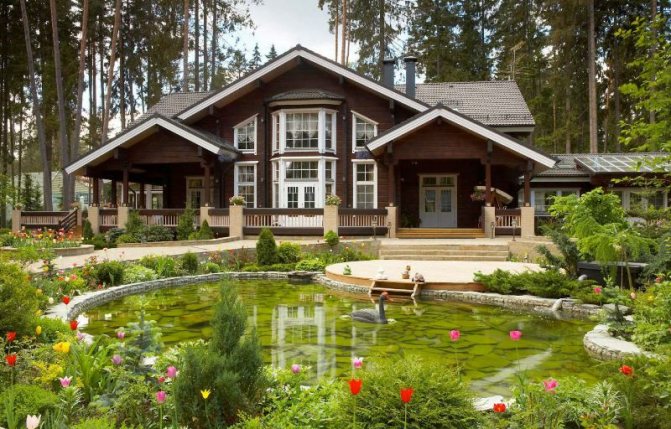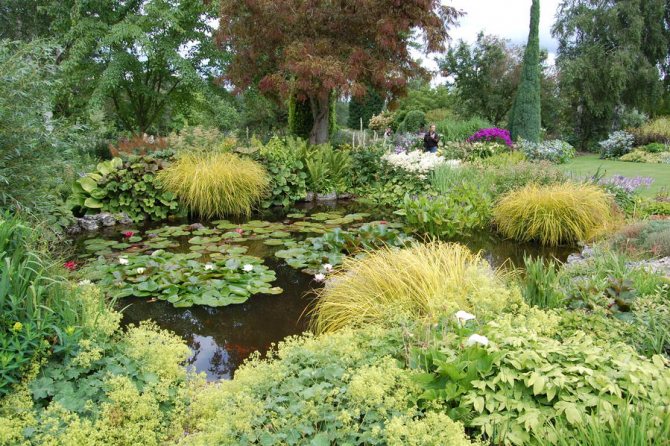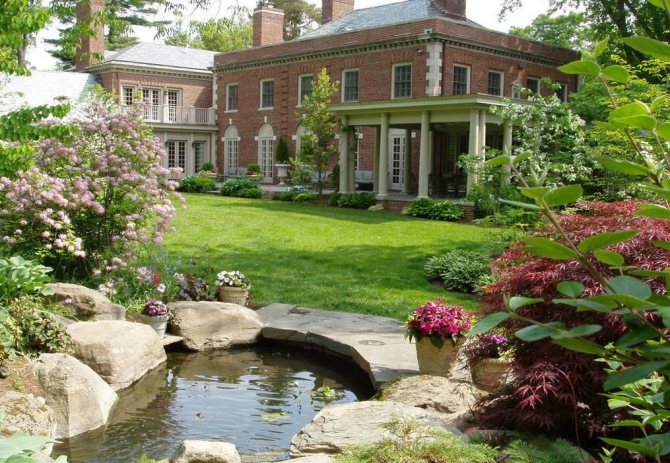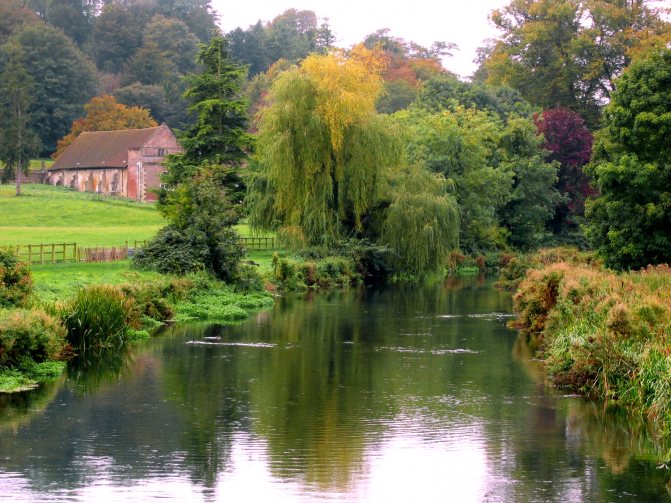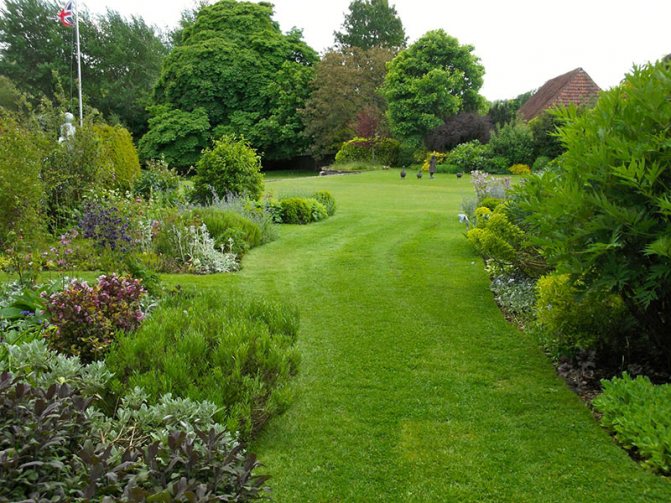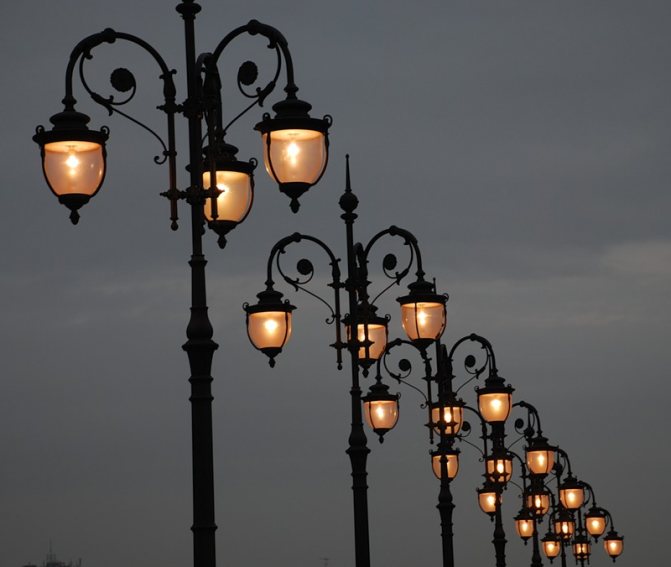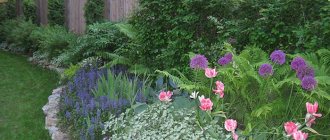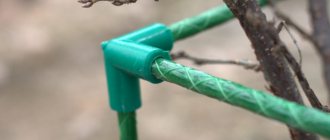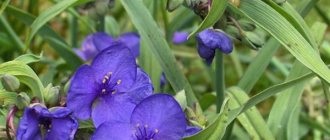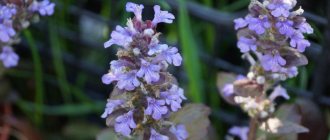Now the English style in landscape design is used quite widely, it is also called landscape. Designers love the combination of simplicity and elegance at the same time, because this is the impression that such a garden makes. An example of one of the ideas for decorating landscape design in the English style is shown in the photo.

Landscaping in the English style
A distinctive feature of the gardens in the English style is naturalness and neatness. When choosing this style for your summer cottage, it is worth considering some details, such as the type of landscape, climate and soil, which should fit the classic plants that are planted in gardens of this type.
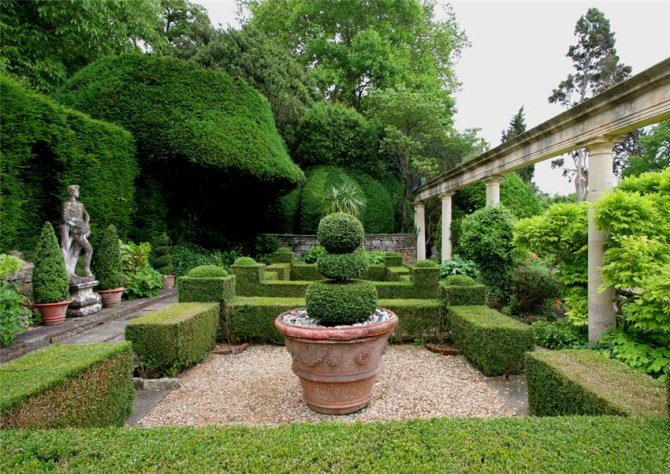

Natural naturalness and accuracy in the English style
Often in the gardens you can see some kind of symmetry along which flowers, fruit crops and trees are planted. So, one of the distinguishing features of English gardens is complete opposition to the ordinary, that is, deliberate asymmetry prevails in them, but always with smooth transitions.
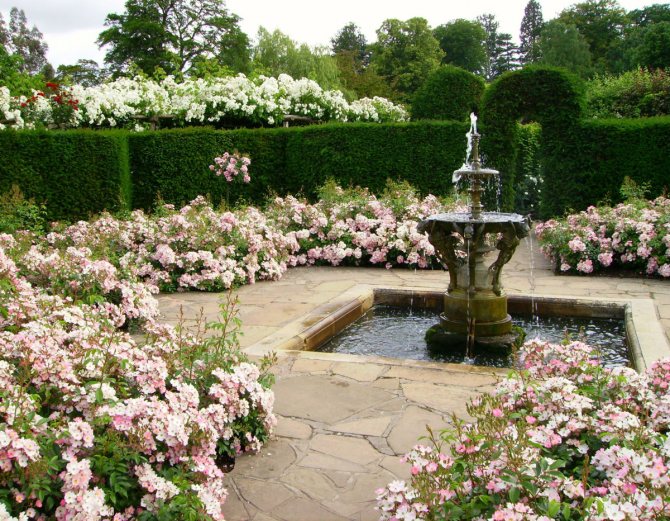

Landscaping of the site in the English style with a fountain
The English-style garden design will take you back to the days of old England, the image of which will be recreated on your site. Stepping onto the porch of the house, you seem to find yourself on the territory of an old English manor or estate. It will serve as a great source of inspiration for writers, musicians and artists. And certainly - a place of harmony and tranquility for people tired of city bustle and worldly problems.
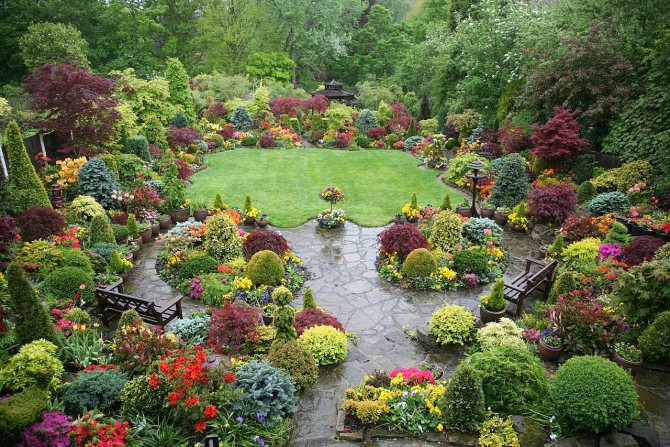

A place of harmony and tranquility for people in an English-style garden
English style garden
The English garden was created to make everything seem natural, to have a place for reflection. The English style values naturalness. The English-style landscape counts on maintaining a balance between the ceremonialness of the English and wildlife, adding elements of romanticism and mystery to the landscape.
Making an English garden is real, even if you have not been to England. The correct use of colors, materials, decorative elements, accessories and plants will transform any garden into a well-kept, stylish and impeccable place.


Wooden benches
The benches are available in both elegant classic and country styles. They can be both with a curved back and legs, and deliberately rough, as if made by a village master in a hurry. But the main requirement that they must meet is a harmonious combination with the rest of the decor elements and with the surrounding landscape.


Wooden benches
Heritage parks and gardens of England
Our ancestors perceived nature as an unfriendly place. It was England that changed our attitude to the environment around us. They began to appreciate the world beyond the threshold of their home, they realized the importance not only practically, but also aesthetically.
The English-style garden has brought many details that seem commonplace to us.
Previously, the English estate included:
A pond - should have been in every English garden, however small, and with winding outlines.
Hedge - such a fence was used to prevent animals from getting close to the house, as well as not obscuring the entire view of the area.
Hilly Lawns - English landscape design is characterized by alternating plains and embankments. Hills reflect the natural landscape better than a dull looking flat field.
Groves of trees - planted near the house. The trees looked great with the lawns in the hills.


Flowers
The English garden is characterized by multi-tiered flower beds, placed in a chaotic manner, without any symmetry and system. The effect is that all these bright flowers appeared on the flower beds on their own, and that people did not plant or grow them at all. And thanks to the use of flowering plants with different flowering periods, flower beds and flower beds look picturesque from early spring to late autumn.
The following plants look good on flower beds decorated in the English style:
- delphiniums;
- lilies;
- dahlias;
- gladioli;
- petunias;
- heleniums;
- phlox;
- daisies;
- irises;
- peonies;
- cornflowers;
- decorative tobacco.
Next to these flowers, medicinal plants and some of the garden plants often grow in the same flower bed. Also, wild flowers are planted in flower beds, for example, clover or dandelions. This gives the flower bed a wild, natural look.
The English landowners who were the owners of such gardens preferred the most persistent and unpretentious of flowering plants. In flower beds, they were planted in rows, in height. The first row, located close to the curb, consisted of undersized plants. Taller flowers grew behind it, and their height increased from row to row. All plants are arranged in height, from low to higher. Thanks to this, it was possible to admire them all, since they do not block each other.
Roses are an important attribute of the English garden. They are traditionally planted near the house. There are also small curly roses that surround window and doorways. Climbing roses can braid trellises and gazebos in the garden.
Important! The lawn is no less an important detail of English landscape design than flower beds and flower beds. In addition to grass and cereal plants, wild flowers are planted on them, such as poppy, field cornflower, meadow chamomile, large-flowered flax, nemesia. Bulbous flowering plants are also planted on lawns: tulips, woodlands, daffodils, cyclamens, crocuses.


Flowers


Shrubs
Features of the English style
The English garden is old-fashioned, natural colors and materials, romanticism and an attraction to antiquity. The English-style landscape blurs the line between nature and modern progress. This is the success of the style, and its constant popularity.
First of all, the English garden is based on geometry that does not catch the eye. If you look from above, the paths meet at one center, and rectangular shapes and circles are combined to give the landscape a sense of order and completeness.


Elements that make the garden truly English:
- Living hedges and flower walls.
Avoid wild, overly lush curbs.
The English landscape is a geometric shape like a circle, oval, square and rectangle.
- Several types of plants.
Mono-concept when choosing plants for a flower bed is the main feature of the English style. Do not plant everything in a row, focus better on 2-3 species, and use different shades of them. You need to have a contrast between the variety of colors and the calmness of the place around you.
- Identical elements in the decoration of the encompassing space and the house.
Repetitive materials like brick or stone in columns, garden walls, fountains and pools can help unify the garden and home.
- Lush flowering of annuals.
They bloom for 4 months, which a perennial plant or shrub cannot boast of. Use annuals in paths, along the edges, or in the center of the flower bed.


Pond
It is difficult to imagine a real English garden without a pond, over which an elegant bridge would not be thrown. The reservoir on the site is one of the integral features of this style. It has the shape and appearance of a natural pond, since its outlines are devoid of clear forms, which often happens in natural conditions.
The shores of the pond are planted with shrubs and trees, and the willow is especially popular as it bends its branches low above the water. And in the pond itself, aquatic plants grow: sedge, cattail, water lilies, reeds. The surface of the reservoir can be covered with duckweed, which also makes it look like a real natural lake. Wooden gazebos
They give the garden an element of mystery and at the same time a certain privacy. Usually these gazebos are located in the depths of the garden, they are surrounded by rough growth of shrubs and trees. They themselves often turn out to be tightly braided with wild grapes, ivy or climbing roses.
Important! Wooden arbors should not be conspicuous: they are hidden behind groups of trees and bushes.
Tracks
It is difficult to imagine an English garden without garden paths. The material for the paths is simple and can be found in any household: tiles, bricks, gravel. The paths can be parallel to each other or single, then the ridges and lawns planted between them will be harmonious.
The basic rule is to narrow the path if it suddenly leads to a secluded and cozy place, and make it wider if the path approaches an open place where people gather.


Gravel path
The design of the English style is a gravel garden path, it does not represent a large cost and is the easiest to build. A limestone or stone border will give the path a finished look and allow it to blend into the English garden.
The English garden is characterized by paths made of stone and paving slabs. These materials are durable and do not require special maintenance. The shape should be rectangular or square.
Paving slabs are decorative and will be a great addition to an English garden. She will serve for several decades.
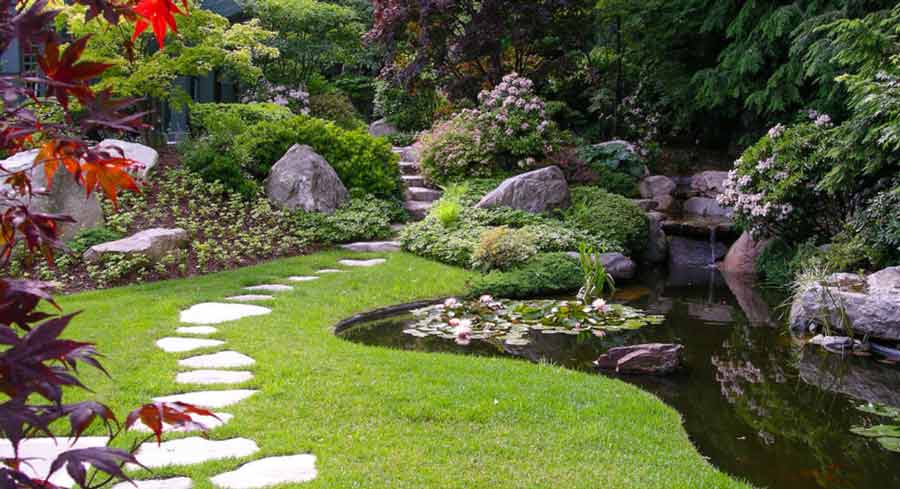

Reservoirs
An English garden cannot be imagined without water. In the gardens of England, you can see a pond at the very bottom of the garden, with benches around. The reservoir should not be deep, and hedges or tall shrubs and perennials should be planted near it.
The classic English garden is a place to relax, so noisy waterfalls and fast streams of water are not suitable for it.
Perennial flowers, trees and shrubs in the English garden
In order to create the ease of the landscape in the English style, you need to plant the plants in layers. The tallest should be planted at the back, lower - their place in the middle, and the smallest on the edge. Observe the color scheme. Choose either only cold shades (purple, white, blue, cold pink), or warm (orange, yellow, red). So you will complete a single concept of the English garden.
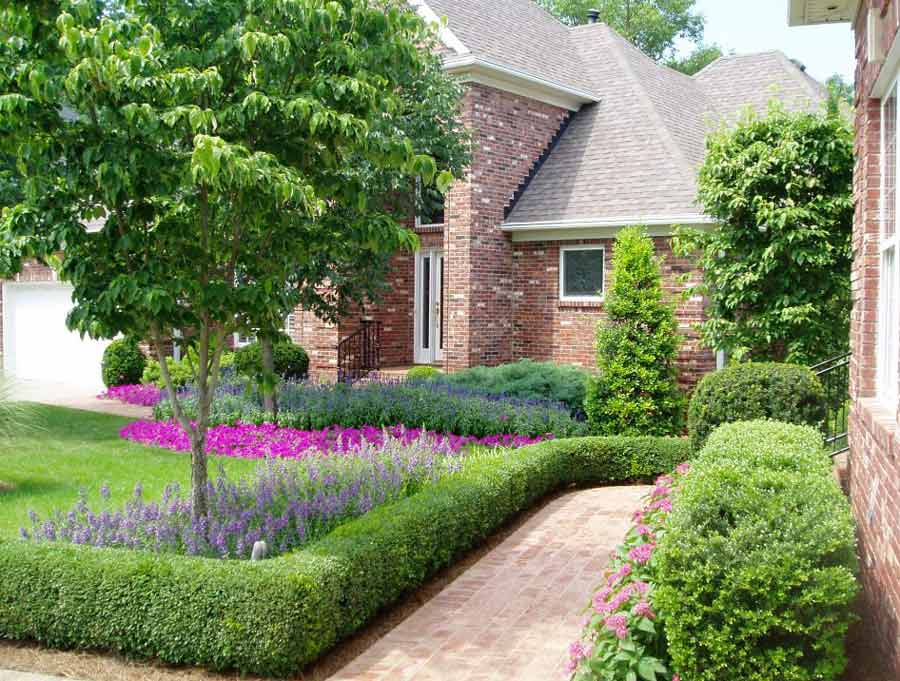

The English people love romantic, old-fashioned flowers. An English garden cannot be imagined without roses (David Austin varieties are very popular), daylily, delphinium, mallow, peonies, foxglove, snapdragon.
An English park cannot be imagined without trees. Yew, hornbeam, eastern thuja, boxwood, magnolia are suitable for hedges. They perfectly tolerate shaping and cutting, and are suitable for the formation of topiary figures. Evergreen spruces, junipers, pines will close the fence.
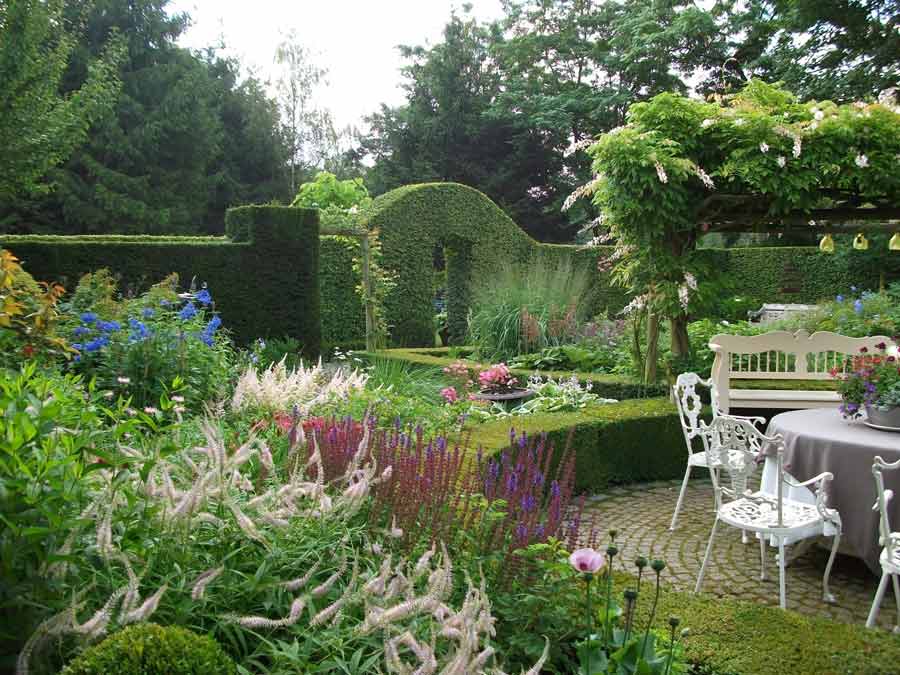

What plants will decorate English landscape design?
Shrinking all the greenery in layers will add a bit of ease. This landing consists in placing the tallest views from behind, after them are medium-sized and only then small. It is important to choose the right color scheme. You cannot combine cold and warm shades. It is recommended to use only one group.
The English style is famous for its romantic, old-fashioned colors.And if your site will be in a dry climate, you need to take care in advance that they have enough water in sufficient quantities. The English style includes the use of roses, mallow, peonies, foxglove, daylily.
For the intermediate level, lavender, hosta and catnip are perfect. They have a subtle color to create a contrast between rich annuals and perennials.
In addition to flowers in English landscape design, it is customary to plant trees. The most suitable are the yew and hornbeam, it is also worth choosing the eastern thuja. Topiary figures are created from them, they lend themselves well to molding and are convenient to cut.
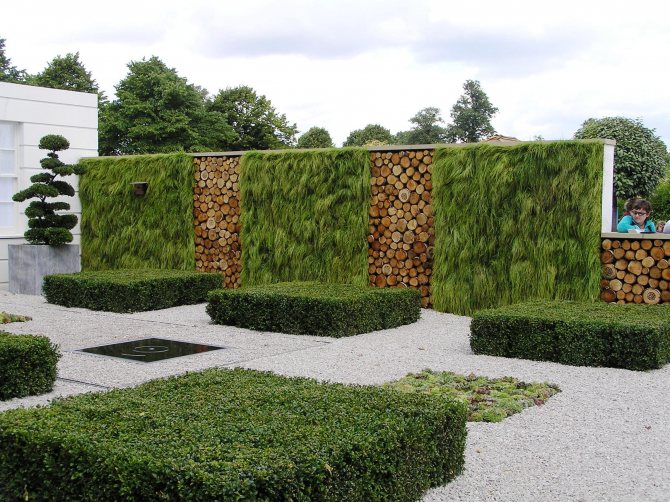

Registration of a summer cottage in the English style
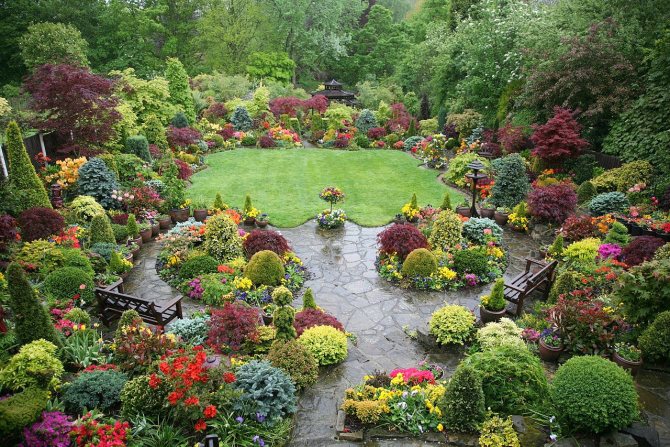

Garden decor in English style


English style in garden landscaping
We create an English garden with our own hands
With 6 simple steps, you can create an English style in any summer cottage.
- Plant several types of plants, only in large quantities.
For example, the New Dawn and William Baffin rose varieties, which, due to their bulk, can decorate large areas of the garden.
- Create combinations of contrasting shades.
The English garden needs the right use of color. Lemon and yellow daylilies are in perfect harmony with purple and violet alliums.
These can be hedges, paths, bird feeders. They fit perfectly into the space, creating the entire integrity of the composition. Fences and wrought iron grates will separate one piece of the garden from another without blocking the entire view.
In the landscape of the English style, instead of the colors we are used to - green, gray, brown, bold, bright shades prevail, which attract their attention. A red table and an orange bench will not let you get bored, even when nothing blooms on the site.
And don't forget about the old days - the older things look, the better they are.
A metal swing will add a romantic touch to the garden. It is best to place them in a shady corner of the garden.
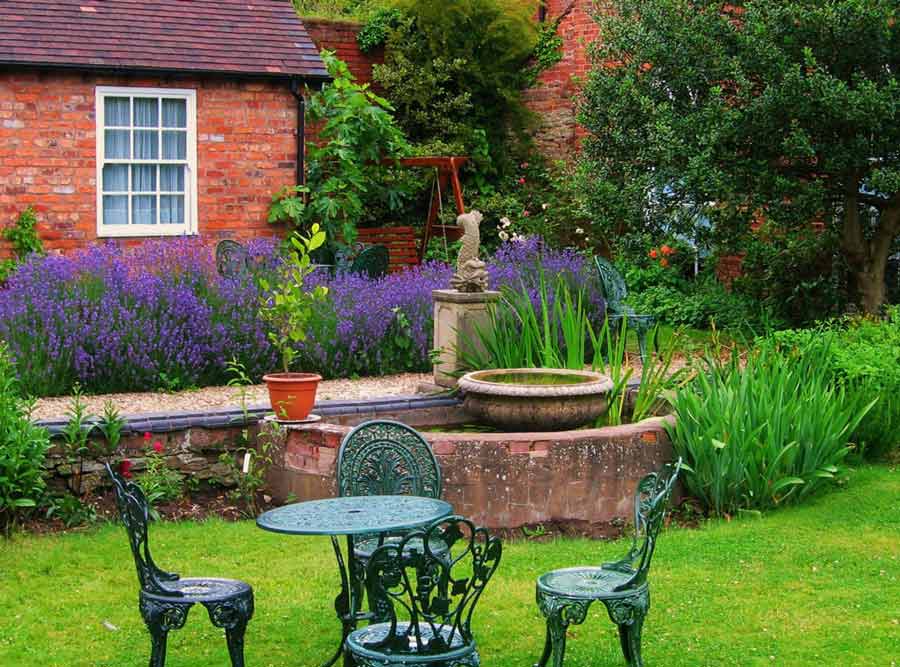

- Concentrate on the inside view.
Fasten the climbing plants around the columns and pillars. It will look very impressive, as if they will float in the air. Stylized ruins and statues can be placed in the English garden.
- Sun and partial shade go well with each other.
In the English-style landscape, there are shade-loving hydrangeas planted near the north wall, and succulents that love bright sunlight.
Trees


In the English garden, it is customary to plant both deciduous and coniferous trees. They often grow next to each other. For example, maple can be adjacent to spruce and larch, which is not always possible in natural conditions.
Trees are located in groups of different densities and at different distances from one another. This creates the illusion of a natural forest landscape. Preference is given to local species that fit organically into the natural landscape surrounding the garden.
Near the ponds, as well as streams and small rivers flowing through the garden, you can see weeping willows growing above the water. They complement the beauty of the landscape and give it peace and tranquility.
The most common trees in English gardens:
- ate;
- larch;
- Oak trees;
- maples;
- yew;
- holly;
- beeches;
- hornbeams;
- linden.
At the same time, evergreen trees predominate quantitatively, which gives the site a picturesque look not only in the warm season, but also in winter.
DIY English-style garden
Every owner of a country house or at least a piece of land undoubtedly wants to create a neat blooming garden that will delight the eye. However, such desires are fraught with a lot of difficulties and even fears: what, where and how to plant and what to do if you want to plant everything and more, and there is only enough space for a couple of flower beds? Don't panic! The most important thing in the matter of arranging a garden is to hear what your soul really desires.And if you have always liked cozy little gardens with rose bushes and winding brick paths, then our today's article is for you, because it will focus on just such a garden - English.
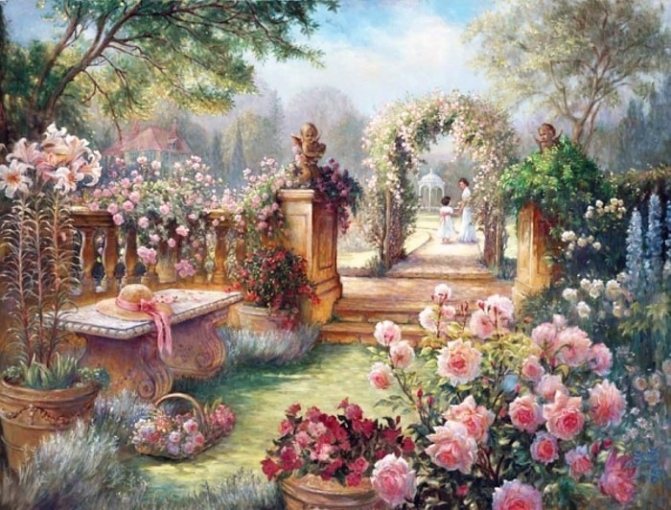

A garden in this style resembles a picture from a fairy tale: lush flowering shrubs, an abundance of greenery, arches entwined with jasmine, and pretty benches, on which it is so pleasant to relax on a hot afternoon. In addition to its aesthetic advantages, the English garden is also surprisingly practical, as it is suitable for arranging on uneven landscapes, and also assumes maximum naturalness.
Therefore, if you are the owner of a hilly patch of land in an open field, then do not rush to ennoble it, because all the shortcomings can play into your hands. The English garden is distinguished by a free layout and the unity of plants and decorative elements - such an arrangement allows it to have a blooming and well-groomed appearance all season. In addition, you will not have corners on the site that are scary to look at.
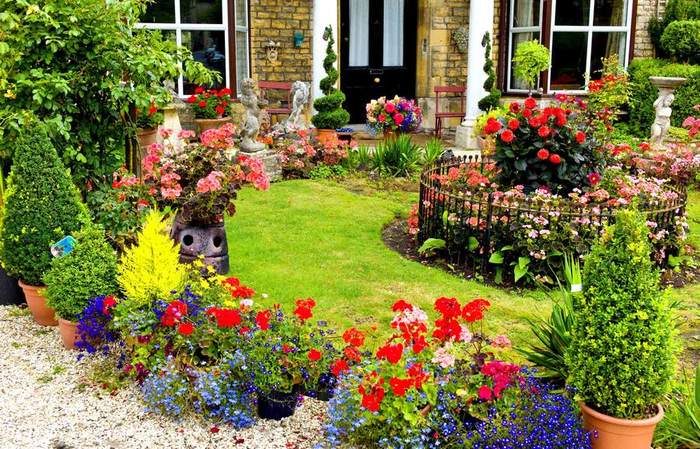

The first thing to remember is that the English garden must be adequately framed. Therefore, immediately forget about a mesh-netting or a corrugated board fence, which will ruin the whole picture with one of their looks. The best framing option for an English garden is a low wooden picket fence or a cross-plank fence. The gate can be wooden or supplemented with wrought iron elements, which will add romance to your garden. The fence itself should not be "bare": an excellent solution would be to plant a climbing rose, lilac or climbing bushes.


A distinctive feature of any English garden is a neat green lawn and paved paths. Despite the fact that the paths are scattered around the garden in a very chaotic manner, they always lead somewhere: for example, to a bench, an arch or a gazebo. The paths do not have to be perfect - ordinary multi-colored pebbles or paving stones are perfect, through which grass will break through here and there.
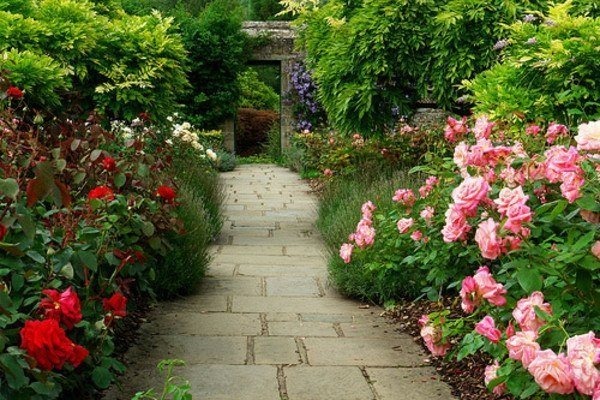

If your plot is extremely miniature in size, then we recommend that you pay attention to the house itself, because an English-style garden is primarily a house surrounded by a garden, and not both separately. You can decorate your home with climbing ivy or wild grapes, and set up a few flower beds or mixborders next to it. The latter are a wide ribbon of flowers and plants that harmoniously complement each other in color and season.
You can also surround the house with potted plants or decorate the terrace in a similar spirit - you will simultaneously get an ideal place to relax and a mini-garden. Creeping shrubs can be planted close to your home, especially if you have exposed beams to grab onto.
Flowers in an English garden are first and foremost roses
... And not just one bush: roses should be everywhere - fragrant, lush and exuberantly blooming. Remember the pictures to Andersen's fairy tales, which are almost always replete with luxurious rose bushes, and pretty kids frolic around them. It is on this image that you should rely on when planning planting on your site. We recently talked about all the intricacies of choosing roses for the garden in this article.
As a rule, there should be at least one arch entwined with roses on the site: it can serve as a simple decoration, or it can additionally play a functional role - to zone the space or serve as a canopy.


When choosing the rest of the plants, focus on the climate and general compatibility: your garden should resemble a variegated carpet that blooms without your special participation. It is no coincidence that the second name of the English garden is landscape.
Quartblog digest
Arrangement of flower beds in the garden: step by step instructions - We create beauty on your personal plot with the help of simple actions.How to equip a flower bed with your own hands? We'll tell you in our step-by-step instructions.
Preparing the garden for the start of the season: Tips for improving space and mood - We are reviving our beautiful garden after a long winter. Preparing your garden in spring: effective tips to improve space and mood.
How to make your garden beautiful: tips for zoning and accents - We talk about garden zoning and more. How you can make a dream garden even from an abandoned wasteland.
In my garden: flowerpots and flower beds - Any garden, even the most luxurious and well-groomed, will not look complete without decorative elements. Today we will talk about flowerpots and flower girls.
Under the cover of the day: DIY ideas for creating a tent on the site - We share ideas on how to create a tent for a summer cottage in our garden with our own hands, we show 5 interesting ways.
How to create a garden in the English style with your own hands
The English Garden is designed to look natural, to be a place for reflection and relaxation. This style appreciates naturalness and invites you to stroll through the garden. The English landscape involves maintaining a balance between the traditional formality, even stiffness, of the British, and wildlife, adding elements of mystery and romanticism to the landscape.
It is quite possible to get the perfect landscape design in the English style, even if you have never been to England and are thousands of kilometers away. The correct use of colors, décor, materials, plants and accessories will transform any garden into a stylish, well-kept and impeccable place. It is these characteristics that are associated with everything that is associated with the country of foggy Albion.
The heritage of the gardens and parks of England
Nature was perceived by our ancestors as a dangerous, unfriendly place. The merit of England is that it was this country that completely changed this attitude towards the environment. They began to appreciate the world beyond the threshold of the house, they realized its importance not only practically, but also aesthetically.
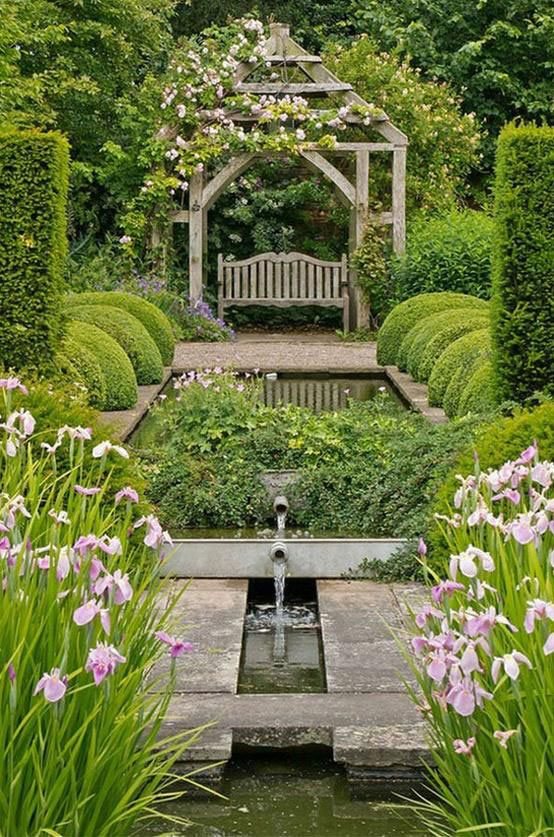

The appearance of the English gardens was influenced by such spheres of science and art as history, philosophy and geometry. The British innovative and integrated approach to landscape design has completely changed gardening. Under his influence, the line between the internal and external space of the house is erased.
The English style in landscape design has brought in many details that seem familiar and commonplace.
So, the classic English manor included:
- There was a pond in every garden, even a small one, but with natural, winding outlines.
- Hedges - This type of fence was used to prevent animals from getting too close to the house, while not completely obscuring the view of the area.
- Hilly Lawns - English landscapes are characterized by alternating mounds and plains. Hills reflect the natural landscape better than a flat field that looks dull.
- Groves of trees - they were loved to plant next to the house. The group of trees looked good with the lawns on the hills.
- Public, open parks - a lot of people came to the English garden to relax, admire the flower beds, socialize and just sit on a bench in the shade of trees.
- The grottoes were romantic hiding places. They were built to resemble natural dark caves, but were shallow and safe.
Decoration and decor


The English park near the house and the exterior itself has several characteristic features - wrought iron gates and gratings, a high chimney, dark wood panels on the walls. Let's take a closer look at what else can be introduced and adapted to our conditions.
English style in landscape design and its details:
- Materials - brick, straw, limestone, cobblestone.
- The decor is a wicker fence, round baskets in the shape of a bee swarm, garden benches, old wheelbarrows.
- Colors - delicate gray, moderate pink, pale cream, olive, all shades of green.
The traditional English landscape is, above all, a skillful imitation of nature. Simple natural materials are used for decoration. If it is a hedge, then it should be low (about 1 meter), woven from willow or sod branches. Hive-style straw baskets with opening lids give the garden a rustic feel and are comfortable and spacious.
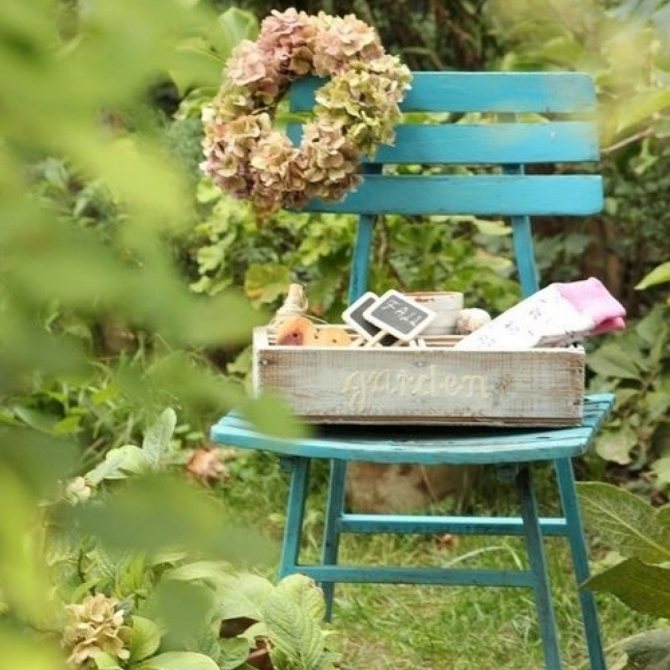

The British do not like to throw away old things, instead, after a small restoration, they find interesting design solutions for them. For example, an English garden, in which it easily fits into the general appearance of a grandmother's wheelbarrow or large cans, especially if they are stylized in antiquity. By the way, flowers will look original if you put them in such a tin instead of a regular pot.
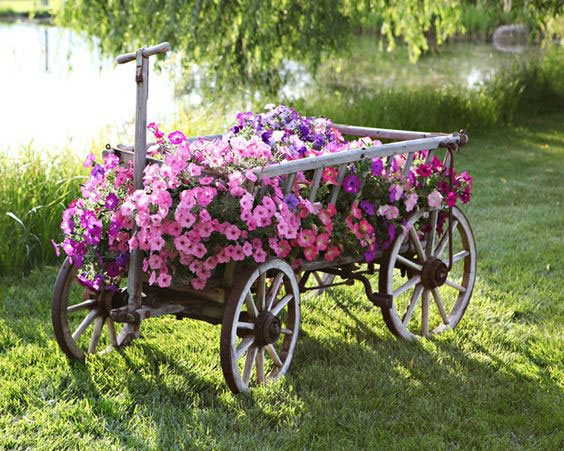

Style features
Design in English is old-fashioned, natural materials and colors, romanticism and a thirst for antiquity. Skillfully selected contrasts give the feeling of a lack of a clear structure and plan. The secret is that there is a plan. The English Garden blurs the line between wildlife and modern progress. This constitutes the success of the style as well as its continued popularity.
Neatly trimmed boxwood hedges sit alongside lush, vibrant flower gardens. Natural materials such as limestone or straw are combined with bricks to combine smoothness with a clear structure.
First of all, the English park is based on geometry that is not conspicuous. When viewed from above, the paths converge to one center, and the circles and rectangular shapes are combined to give the landscape a sense of order and completeness.
Mandatory elements that will make the garden truly English:
1. Low hedges and flower walls.
Visually, this delimitation of different zones in the landscape will give the effect of a labyrinth and mystery as you move forward. Avoid wild, overly lush curbs.
English landscapes are basic geometric shapes like oval, circle, rectangle and square. Each part of the space should be clearly organized.
2. Several main types of plants.
Mono-concept when choosing flowers for a flower bed is one of the key features of the English style. Do not try to plant everything in a row, it is better to focus on two or three types, but use their different shades. There should be a contrast between the variety of colors and the sophisticated calmness of the environment.
3. Identical elements in the decoration of the house and the surrounding space.
Reusing materials such as stone or brick in garden walls, columns, pools, and fountains can help unify the home and garden. Emphasize a skillfully chosen combination of different textures so that the garden becomes an integral part of the living space, and the house itself becomes an extension of the external space.
4. Abundant flowering of annuals.
Details you need to create the right atmosphere
There are some details that are a must if you want your garden to be in the English style. The elements are as follows.
Flower walls and low hedges
This will create a visual maze effect that creates a sense of mystery every time you move forward through the garden. Very curvy curbs should not be used.
The presence of several types of greens in the base
In the English style, when creating a garden, it is not allowed to plant whatever you want. It is recommended to limit yourself to a maximum of three types. Choose different tones for a change. The end result is an abundance of colors, not species.
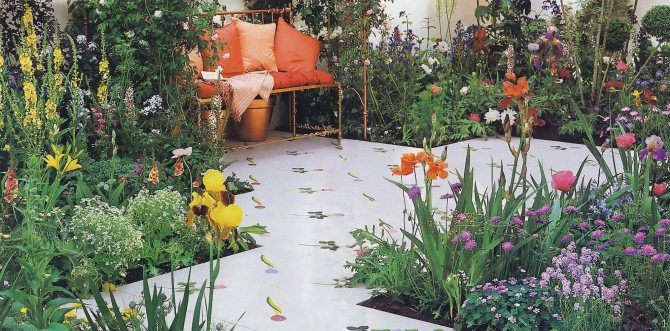

Beautiful landscape design in the English style


Registration of a summer cottage in the English style
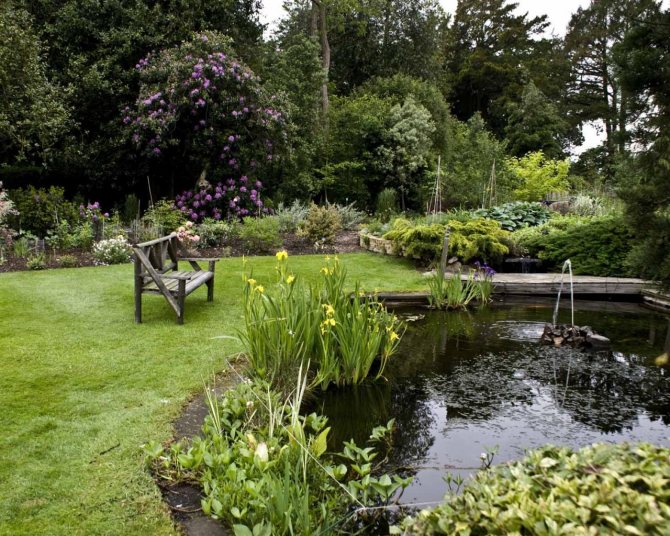

Garden decor in English style
The use of the same elements when decorating the house and everything that surrounds it
This will help bring him and the garden together, making them one. In this case, it is recommended to focus on a combination of textures, which should be correctly selected. The garden should become an integral part of the house, and it, in turn, should look like an extension of the external environment.
Strong flowering of annuals
They can bloom within 5 months. Therefore, they should be planted in the garden, preferably in the central part of the flower bed, along its edges, not far from the paths. An important feature of an English-style garden is the presence of bright, luscious spots and a basic calm background.


English style in garden landscaping
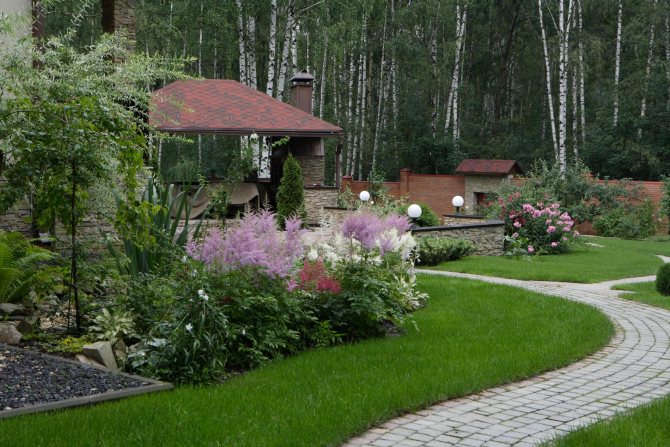

Suburban area in the English style
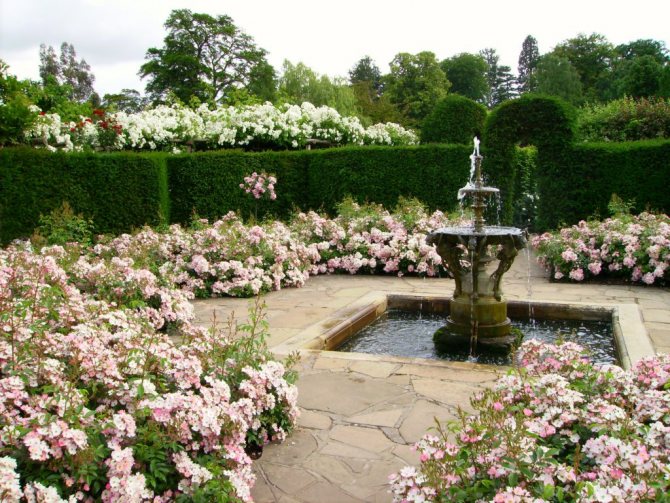

Beautiful landscape design in the English style
A piece of wildlife on the site
You heard right - today we will create a natural landscape on the site, for which it is not necessary to have a large area, even a piece of land is enough. It may even seem at first that special difficulties should not arise, and you don't need to apply a lot of effort, but this is deceptive.
You must first learn as much as possible about the features of the landscape and local flora. It is also desirable that you have a sense of proportion and artistic taste.
Difference in style
Elements and details in a landscaped garden should be natural in appearance, the main lines of this nature park are smooth and soft. Be prepared that an English garden is in many ways the opposite of conventional landscaping.
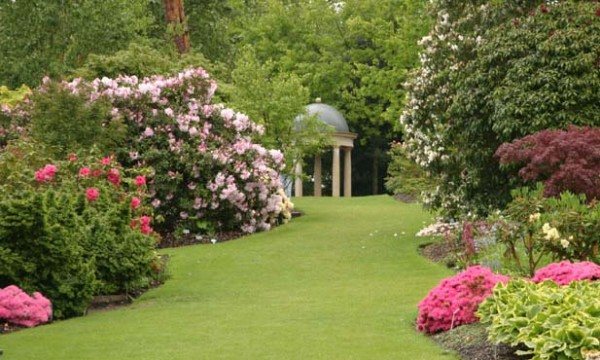

English landscape garden with lawn
If the latter is dominated by symmetry, clarity and correctness of lines and geometric shapes, in our case the instruction requires an asymmetric composition. Straight lines are replaced by winding ones; you will not find geometric shapes here either. Below will be given detailed explanations of all the wisdom.
It just so happened that both the landscape version of landscape design and the romantic style in art developed in parallel. Nature has served as a source of inspiration for writers and artists. This has evolved into a typical English garden, with a perfectly manicured lawn and trees and flowers arranged to create a natural impression.
At the same time, the landscape in the English style makes it possible to find yourself in a natural setting immediately outside the threshold of your home. If you decide to create a landscape garden on the site, you will be able to repeat the atmosphere of the old manor and noble estates of the romantic 19th century. Having created a natural park, you will always have a place where you can draw inspiration, be in harmony with yourself thanks to the singing of birds and the murmur of a stream.
Style features
There are many of them, but we will focus on the main ones:
- Copying the natural landscape on the site should be as natural as possible. If these are garden paths, they should be made winding, a pond with a bridge should form a single whole with the surrounding landscape, and not stand out against its background.


English garden with a bridge
- English-style garden care should be as invisible to the eye as possible, but this does not mean that everything should be left to chance. On the contrary, it requires constant maintenance of the territory in the desired form. The same applies to the lawn, which needs to be mowed regularly, the tradition goes back centuries, so there will be nothing special in this.
- Select plants carefully, choosing local varieties that are already well adapted to the climatic conditions. Then your English garden will look good at any time of the year.
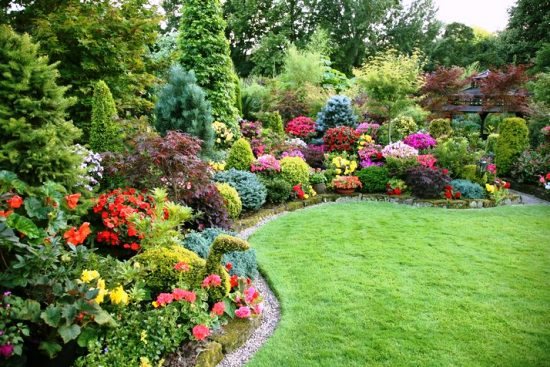

Plants in the English garden
Tip: in the country, creating a landscape style should begin with laying a lawn. Then around it you need to arrange various compositions - groups of trees and shrubs, lawns, flower beds.
- Experts recommend creating a full-fledged English garden only over a large area. But, do not be discouraged if your plot is small, the natural landscape will look great even in a small corner of it.
A small pond in the garden is a must
- You cannot do without a pond - this is a prerequisite for style, even if its price seems high to you. It is also desirable that water lilies grow in it, a duckweed float on the surface, and picturesque thin willow branches lean over it.
Tip: if there is already a pond on the site, clear its banks and plant plants along its banks to your liking, and then take care of it. When the reservoir is small, several or even one dwarf weeping willow will look good next to it.
The banks of a traditional pond in the English style are usually lined with gray stone, there are no clear outlines, and the plants along the banks look like a real natural composition.
- You can combine different areas of the garden with the help of winding paths made of natural materials - sandstone or cobblestone.


Entrance to the house in the English style
- Traditionally, English houses are simply buried in flowers and greenery. Therefore, it will not be superfluous to plant a large number of unpretentious flowers in the garden and next to the house to recreate the English style in landscape design.
Good for landscape style:
Look great in spring:
Tip: Plant flowers in flower beds in groups and densely enough to create a beautiful combination of places with flowers on low and high stems.
Do not forget - lush plants are used in English flower gardens, because the climate here is almost constantly humid.
How to choose decorative elements
Any style can become brighter if it is supplemented with various decorations:
| Gazebos and arches | Arbors entwined with grapes and ivy, flower arches and trellises, on which climbing plants can also be put, benches in recreation areas, go well with a landscape garden. |
| Materials (edit) | We recommend using:
The latter can be used literally everywhere - this is a gazebo, a bench, a hedge, and a bridge over the pond. They will help, in combination with wood, to form a complete ensemble. |
| Decor |
|
| Wall decoration | Most often it is ivy, which can be of different types. It is very good if you can use two of them at the same time, for example, with variegated and green leaves, which will add color to the setting. |
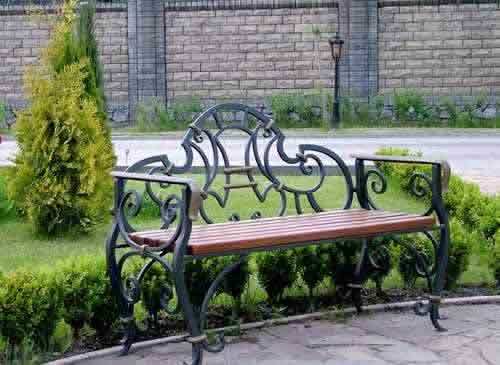

Forged items go well with wood
Tip: when creating an English-style garden, strive for each element to be in harmony with nature, not to be conspicuous, but to be part of the overall composition.
Constructions
England, having become the center of garden fashion, suggested combining seemingly incompatible things in gardens and parks - greenery and stones. Huge old vases on a pedestal, standing in the middle of a perfectly trimmed lawn, statues of beautiful young men and women, brick arches over the gate - all this is a tribute to the past.
The entrance to the house is a special place, like a visiting card of the owners. Branched roses, under which the brick arch above the entrance is almost invisible, provide not only aesthetic pleasure. They declare that the garden in the English style begins from the very threshold, with powerful supports of the arched vault, entwined with delicate and fragrant flowers.
The British know how to honor their traditions and ancestors, so symbolic ruins of columns, castles and fortresses are often found in their gardens. English landscapes abound in this historical flavor. And on our soil, it will be replaced by large blocks of rough stone, cobblestones and bricks as part of an unfinished wall. The main thing is to measure the area of the site with the size and number of design elements on it.
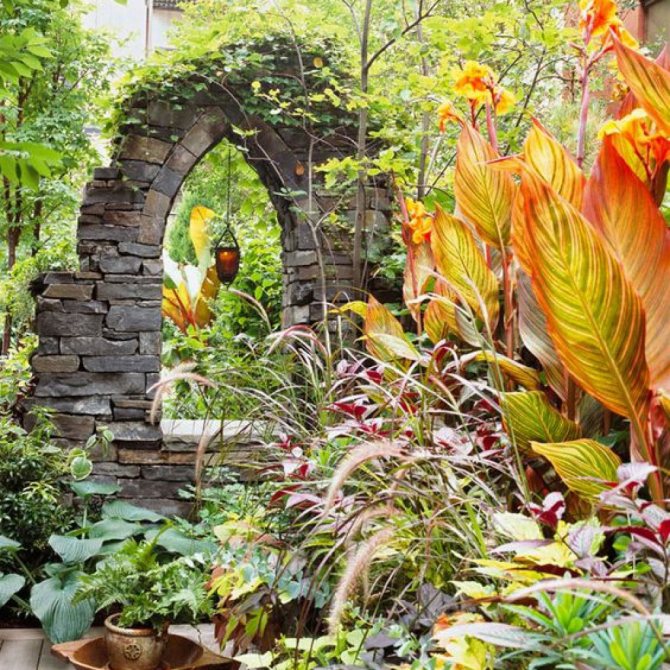

The grotto as an imitation of a natural cave is undeservedly considered a relic of the era of romanticism. It was the gardens of England that became an example when creating artificial grottoes on a limited plot of land. Internal voids, small in size and equipped, are perfect for secluded relaxation, pleasant memories and contemplation of the landscape. Especially on hot summer days, when you want coolness so much! However, remember that English landscape design requires a thoughtful approach, so it is better to entrust the process of constructing a grotto to a construction professional in order to think over all the technical details and guarantee safety.
It will be useful to read:
Provence garden style Endless lavender fields and vineyards, silence and tranquility, mixed with the sea air - this is Provence. Do ...

